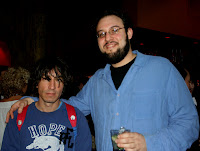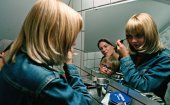Is it true you were the skateboard champion of
Many, many years ago, yes. I started skateboarding during a period when skateboarding was banned in
In fact, I had started making videos as a child. My grandfather, Erik Lochen had a film called The Hunt (that has screened at
Skating and punk both involve so much self-expression. Do you refer to these experiences when you make films?
I found these to be helpful in the sense that directing entails dealing with pressure and trying to inspire those around you. In skateboarding you can hone a sort of style, but you cannot thematically deal with anything as you can in cinema. I was never good at writing in the literary sense of the word, and was never a musician, so I yearned for something else. In fact I did co-write the script for Reprise, but always aiming for the image.
Would you talk about your connection to Truffaut’s Jules and Jim, which several critics have brought up in conjunction with Reprise.
It has been brought up a lot, and I do like Truffaut, but I also like a lot of the French New Wave, and particularly Alan Resnais. Hiroshima Mon Amour and Last Year at Marienbad were more what we were inspired by for Reprise than Jules and Jim, although that’s been the one to come up with the critics. Of course it is a huge compliment to be associated with a director like Truffaut. I love the French New Wave in general, Goddard, the writer Alain Robbe-Grillet. And while the opening scene in Reprise does allude directly to the New Wave, ‘inspired by’ would be a more accurate way to characterize the relationship.
Oh I was so convinced…
It’s great that different people have different reactions to the film. One Norwegian critic, and I took this as a huge compliment, said that Reprise was ‘Antonioni on amphetamines!’ So a lot of stuff has come up. All in all I’m a big film buff, I grew up watching these films. For Reprise I was inspired by films like Diner by Barry Levinson, or Annie Hall, or Before The Revolution by Bertolucci. Many, many things, although Truffaut is relevant.
Did you watch any of these while shooting Reprise?
No, it was more subconscious. I never watch a film and then consciously try to make a pastiche of it. But our minds are made up of the iconography of cinema in a way. And I want to let the audience be a part of this discourse. In Reprise, I think the pastiche is in the more humorous parts. Like the beginning, what we always call the overture of the film, which introduces the story, presents the themes of the movie, which will then proceed very differently. I guess that is rather New Wave.
In Reprise you embrace the iconography, as you put it, of these early postmodern filmmakers in a wholly postmodern way…
Well, as a student, I named two films after Jean Baudrillard books. I’m not an academic but I’m hugely inspired by theory, especially French Poststructuralist theory, but all kinds of theory, really. That’s not to say I want to illustrate theories in my films, but I do find it inspiring to ask questions about perception of reality and identity.
And just a little note on your notion of postmodernism: I’ve always asked myself if there ever really was a modernism in cinema, or was it just automatically postmodern from the get-go because of the nature of the medium. Film was already a mixture of high and low culture, it was already dealing with representational identity, it was very often an conglomerate of many means of cultural expression, and very early on film engaged with the notion of identity, and the fluidity of identity and point of view. So I often find words like modernism and postmodernism to be empty when it comes to cinema, which lacks a clear art historical development.
But it seems to me that modernism is ingrained in cinema somehow, that cinema is a form that comes from modernism…
Peter Schepelern, the Danish theoretician, tried to find that break, when modernity as such became postmodernity. Where can we find it? There is always something postmodern there at play in the language of cinema.
May I suggest that your film iterates this break…
Oh yes?
In the sense that it is much more difficult for you or any other contemporary filmmaker not to cite, that the filmic vocabulary, as it were, has grown so much since 1960, never mind 1895.
But if you look at Goddard, he was constantly citing. I mean, look at the Claire references, the American references in his early work. Truffaut as well, was playing with gangster and film noir. You see, I think it was already there, postmodernity, the break was already there, whether one likes it or not.
With all this talk of French filmmakers, I’d like to ask you about the role
Yes, yes! Buttes-Chaumont is a special park, and my co-screenwriter, Eskil Vogt, lives nearby. He is also a director, in fact. And I spend a lot of time in
 And Philip, too, is split. Try as he might, he cannot resummon his love for Kari.
And Philip, too, is split. Try as he might, he cannot resummon his love for Kari.
Eskil and I have a very close friend who was schizoaffective. So we knew about this disorder, which is a combination of a sort of psychosis and bipolar disorder. And we were interested in dealing with mental illness but did not in any way want to do a sociological study. Instead, we aimed for the metaphor of ambiguous identity. In reality, the myth of the mad artist is very sad: Van Gogh was not productive when he was in a psychotic state, it is a terrible tragedy for these people. And then we paired Philip with Erik, a character almost out of Henry James, the kind of person who longs for catastrophe, and feels the unbearable lightness of things. At its core, Reprise is the story of friendship.
And then, in terms of identity, I’d like to say something about
Reprise is also rich in its portrayal of male relationships…
Well, I was very interested in that. I wanted to make a complex film about male interaction. I think people are quite mixed, and I wanted to show these guys who talk roughly but are fragile. And the moment they stop being so close, this sort of talk stops. I really tried to capture that particular way guys have of communicating.
Notions of identity and autobiography are constantly in play in Reprise. Manohla Darghis, for one, wrote about the title of Erik’s book, “Prosopopeia,” citing the theorist Paul de Man on autobiography. Come to think of it, how autobiographical is Reprise?
It is and it isn’t. Both [co-screenwriter] Eskil Vogt and I used a lot of ourselves, and I did find many parts of Philip and Erik that I could relate to. It’s a very personal film, in language and form, because the characters and I come from same milieu. You see, process is incredibly important to me. For me, the most important thing is to express feeling and mood with my films. It’s so difficult to do, but it’s what we all aim for. So when people talk about a film being ‘personal,’ they often only mean autobiography. Yet, there are other ways a film can be very personal. As a director, your mise-en-scene combined with your approach to time are what make your films your films.
As to Prosopopeia, it’s a Greek term meaning ‘to give voice to.’ “The voice of the woods,” for instance would be Prosopopeia. I understand what she’s referring to in talking about Paul de Man, and we’ve never had anyone spot that, so I really appreciated it. Also, Erik gives his book that impossible title, which I find very endearing.
Is it true that most of the actors were amateurs?
I had lived seven years in
-Interview by Jon Robbins














































